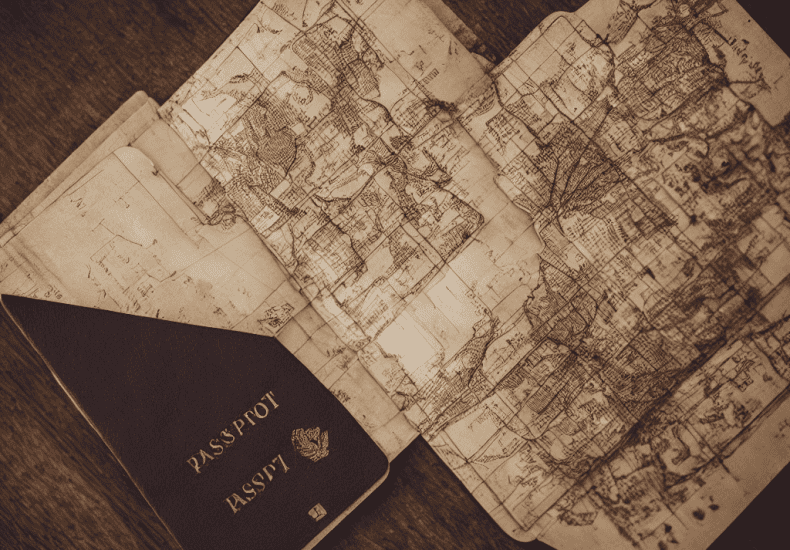
A Step-by-step Guide on What to Do When You Lose Your Passport
I still remember the day I lost my passport while traveling through Europe – it was as if my sense of security and freedom had been uprooted. I was in the midst of a life-changing journey, and suddenly, I found myself facing a daunting challenge: what to do when you lose your passport while traveling. The uncertainty was overwhelming, but as I navigated through the process, I discovered that it wasn’t as catastrophic as I thought. In fact, it became an opportunity for growth and a chance to practice mindfulness in the face of uncertainty.
As someone who’s passionate about mindful living, I’ve learned that even in the most chaotic moments, there’s always a way to find calm and clarity. In this article, I’ll share with you my personal story and provide you with practical advice on what to do when you lose your passport while traveling. You’ll learn how to stay calm, replace your passport, and get back to your journey with minimal disruption. My goal is to empower you with the knowledge and confidence to handle this situation with ease, so you can focus on what truly matters – exploring the world and cultivating a deeper sense of self-awareness.
Table of Contents
Guide Overview: What You'll Need

Total Time: 2 hours to several days
Estimated Cost: $100 – $300
Difficulty Level: Hard
Tools Required
- Computer (with internet access)
- Phone (for making calls to embassy or consulate)
- Scanner (for scanning documents)
- Printer (for printing documents)
Supplies & Materials
- Passport Photo (1 or 2, depending on requirements)
- Proof of Citizenship (such as birth certificate or naturalization certificate)
- Government-Issued ID (such as driver’s license)
- Travel Itinerary (proof of travel plans)
- Police Report (if passport was stolen)
Step-by-Step Instructions
- 1. First, take a deep breath and acknowledge that losing your passport while traveling can be a stressful experience, but it’s not the end of the world. Remember, many people have been in your shoes before, and with the right steps, you can get back on track. Start by gathering your thoughts and making a mental note of the last place you had your passport, as this information might be crucial for the next steps.
- 2. Next, report the incident to the local authorities, such as the police, to obtain a report that can be used as proof of the loss. This step is essential for securing a replacement passport, as it verifies the circumstances under which the passport was lost. Be sure to keep a copy of the report for your records, as you will likely need it when applying for a new passport.
- 3. Contact your home country’s embassy or consulate in the country where you are currently located. They will guide you through the process of obtaining a replacement passport, which may involve filling out forms, providing identification, and paying a fee. It’s crucial to follow their instructions carefully, as the requirements can vary depending on your nationality and the specific circumstances of your case.
- 4. Gather all necessary documents to apply for a replacement passport. These typically include a birth certificate, a government-issued ID, and proof of citizenship. If you have digital copies of these documents, make sure they are easily accessible, as you may need to upload them as part of the application process. If not, consider scanning them to have digital backups for future reference.
- 5. Fill out the application form for a replacement passport, which can usually be found on the website of your country’s passport agency or provided by the embassy/consulate. Be meticulous when filling out the form, as accuracy is key to avoiding delays in the processing of your application. If you’re unsure about any part of the form, don’t hesitate to reach out to the embassy/consulate for clarification.
- 6. Submit your application, along with all required documents and the application fee, to the embassy/consulate. The processing time can vary, so it’s a good idea to plan ahead and consider the urgency of your travel plans. Some countries offer expedited services for an additional fee, which might be worth considering if you have imminent travel arrangements.
- 7. Once your replacement passport is ready, you will be notified by the embassy/consulate. They will provide instructions on how to collect it, which might involve picking it up in person or having it mailed to you, depending on their policies. When you receive your new passport, take a moment to double-check that all the information is correct and that it has not been damaged in any way. This is also a good time to make digital copies of your new passport and store them securely, in case you need them for future travel arrangements or identification purposes.
Navigating Lost Passports

As I sit in my garden, surrounded by the gentle hum of nature and the rustic charm of my vintage gardening tools, I am reminded of the importance of preparation and planning. Just as a gardener must prepare the soil for a bountiful harvest, travelers must take steps to ensure a smooth journey. This includes making digital passport copies and leaving a copy with a trusted friend or family member back home. In the event of a lost passport, having access to these copies can expedite the passport replacement process.
Navigating the complexities of lost passports can be daunting, but it’s essential to remain calm and focused. I often find solace in the emergency travel documents that can be obtained from the US Embassy services abroad. These documents can provide a sense of security and allow travelers to continue their journey while they await their new passport. It’s also crucial to understand the travel insurance for lost passport options available, as some policies may cover the costs associated with replacing a lost or stolen passport.
As a life coach, I emphasize the importance of mindful preparation. Before embarking on a trip, take the time to research and understand the pre trip passport preparation requirements. This includes knowing the location of your country’s embassy or consulate, as well as having a plan in place for emergency situations. By being proactive and prepared, travelers can minimize the stress associated with lost passports and focus on enjoying their journey.
Emergency Travel Documents Uncovered
As I reflect on my own journeys, both physical and metaphorical, I’ve come to realize the importance of being prepared for the unexpected. When it comes to navigating lost passports, having the right resources at your fingertips can be a lifesaver. I’ve found that staying informed is key, whether it’s through government websites or travel forums. For instance, if you’re planning a trip to Spain, you might want to explore local resources, such as Sexo en Madrid, which can provide valuable insights into the city’s culture and community. By doing your research and understanding the local landscape, you can better equip yourself to handle any challenges that come your way, and focus on what truly matters – embracing the beauty and wonder of the world around you.
As I sit in my garden, surrounded by the gentle hum of nature, I’m reminded of the importance of being prepared for life’s unexpected twists. When it comes to emergency travel documents, it’s crucial to understand the options available. An emergency passport, for instance, can be a temporary lifesaver, allowing you to continue your journey while your permanent passport is being processed.
I recall a client who found herself in a similar predicament, and we worked together to navigate the process of obtaining an emergency travel document. It was a valuable lesson in resilience and adaptability, much like the art of pruning a plant to encourage new growth. By embracing the uncertainty and taking deliberate steps, we can transform challenges into opportunities for growth, just as a well-tended garden flourishes with care and attention.
Pre Trip Passport Preparation Wisdom
As I tend to my garden, I often reflect on the importance of preparation. Just as a well-planned garden layout can prevent chaos, pre-trip passport preparation can save us from unnecessary stress. I recall a client who had a separate folder with scanned copies of their passport, driver’s license, and travel insurance – a simple yet effective strategy. By having these documents easily accessible, they could quickly respond to any unexpected situation.
I recommend making digital copies of your passport and leaving a copy with a trusted friend or family member. This way, if your passport is lost or stolen, you can easily access the information and get a replacement. It’s also a good idea to make a physical copy and store it in a safe place, separate from your actual passport. By taking these simple steps, you can ensure a smoother journey and avoid unnecessary headaches.
Finding Your Way: 5 Essential Tips for Navigating a Lost Passport
- When wanderlust meets trouble, stay calm and think clearly – it’s the first step to getting back on track
- Report your lost passport to the local authorities and your home country’s embassy as soon as possible, it’s like pruning a garden, you’re cutting away the dead to let the new grow
- Make digital copies of your important documents, including your passport, and leave a copy with a trusted friend or family member – it’s like planting seeds for a safe harvest
- Understand the process for obtaining an emergency travel document, it’s not a full passport but it can be a temporary lifesaver, like a vintage gardening tool that still gets the job done
- Prevent future stress by making sure your passport is valid for at least six months beyond your planned departure date from any foreign country, it’s like nurturing a garden for the seasons to come
Mindful Traveler's Key Takeaways
Embracing the unexpected is part of the journey: when losing your passport, breathe, stay calm, and remember that it’s a setback, not a roadblock to your adventures
Preparation is the best companion: taking simple steps like making digital copies of your passport, leaving a copy with a trusted friend or family member, and knowing the location of your country’s embassy can make a world of difference in navigating a lost passport
Cultivating patience and resilience is key: whether you’re waiting for a replacement passport or dealing with the bureaucracy of travel documents, remember that these moments are opportunities to practice mindfulness, reflect on your journey, and appreciate the beauty of slowing down
Finding Peace in Turbulent Travel
Just as a gardener tends to their soil with gentle care after a storm, we must nurture our sense of calm and clarity when life’s journeys take unexpected turns, like losing a passport – for in the stillness, we find the wisdom to navigate even the most turbulent of travels.
Nicholas Griffin
Finding Peace in the Midst of Chaos

As we’ve navigated the journey of losing a passport while traveling, it’s clear that preparation and calmness are key. We’ve covered the essential steps to take when your passport goes missing, from contacting authorities to obtaining emergency travel documents. It’s also important to remember the wisdom of pre-trip planning, ensuring you have all necessary documents and information readily available. By being mindful of these details, you can turn a potentially disastrous situation into a mere bump in the road.
As you move forward, whether you’re currently dealing with a lost passport or simply planning for the future, remember that growth often arises from unexpected challenges. Let this experience be an opportunity to cultivate inner peace and resilience, just as a gardener nurtures their plants through the seasons. By embracing the unknown with an open heart and mind, you’ll not only survive the loss of a passport but thrive in the face of any obstacle that comes your way.
Frequently Asked Questions
What are the most efficient ways to report a lost passport to the relevant authorities while abroad?
When reporting a lost passport abroad, I recommend contacting your home country’s embassy or consulate immediately. They’ll guide you through the process of obtaining an emergency travel document. Additionally, file a police report locally, as this will be required for replacement. Stay calm, and remember, it’s a setback, not a roadblock – just like pruning a garden, it’s an opportunity for new growth.
How can I obtain an emergency travel document if I'm in a remote area with limited access to embassy or consulate services?
When stranded in a remote area, don’t worry, my friend. You can reach out to your home country’s emergency travel document services, often available 24/7, or contact a nearby embassy or consulate for guidance – even if it’s just a phone call away, it can be a lifeline to get you back on track.
Are there any additional steps I can take before my trip to prevent or prepare for a lost passport scenario, such as registering with my government's travel advisory department?
Registering with your government’s travel advisory department is a great move – it’s like pruning your garden before a storm, preparing for the unexpected. I also recommend making digital copies of your passport and leaving a copy with a trusted friend or family member, so you can access vital info from anywhere.
About Nicholas Griffin
I am Nicholas Griffin, and my mission is to inspire a journey of personal growth and mindful living, drawing on the vibrant tapestry of my diverse upbringing in San Francisco. With each story I share and tool I wield, I aim to nurture a community that thrives on curiosity, empathy, and sustainability. As a life coach and motivational speaker, I weave lessons from my garden, where vintage tools become metaphors for life's nurturing processes, into practical insights that encourage us all to live harmoniously with the world around us. Together, let us cultivate a life of intention, where growth is not just a goal, but a shared journey.
Leave a Reply
You must be logged in to post a comment.